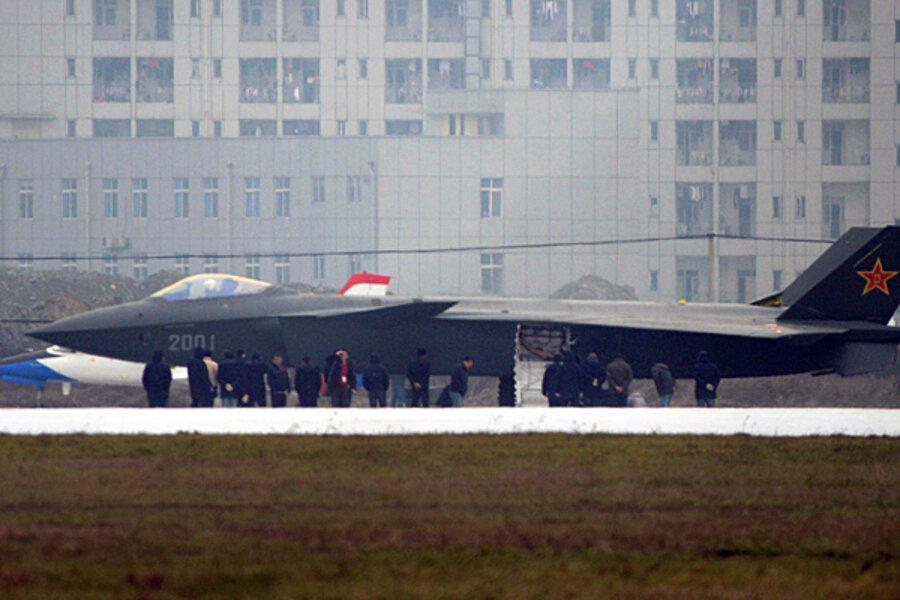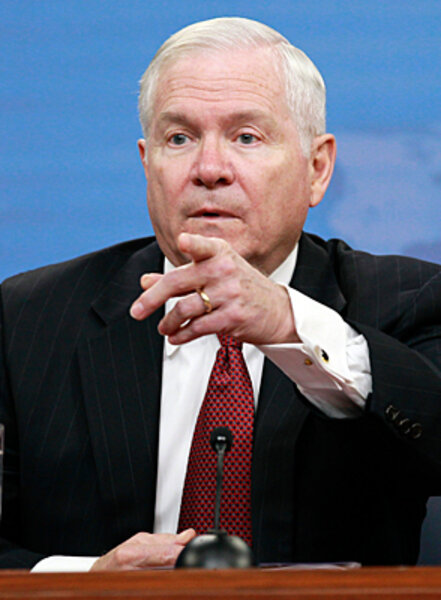Gates's challenge in China: Why he's looking far beyond J-20 stealth fighters
Loading...
| Beijing
If US Secretary of Defense Robert Gates decides to pass the time on his flight to Beijing on Sunday by studying photos of the “stealth” fighter jet that China unveiled this week, he can draw comfort from one fact of which Beijing is all too aware.
By the time the first Chinese “Jian 20” plane makes its first operational flight sometime toward the end of this decade, the US Air Force is due to have more than 1,000 equally advanced planes in the air, and years of experience flying them.
The new Chinese fighter “will not make any difference to the balance of power for another 10 years or so,” says Ted Galen Carpenter, a defense expert at the Cato Institute in Washington. “But psychologically and symbolically it’s important."
"America keeps looking over its shoulder and sees China gaining,” Dr. Carpenter adds. “The gap is still there, but it is getting smaller.”
In three days of meetings with Chinese civilian and military leaders, Mr. Gates is unlikely to raise US concerns about any particular Chinese weapons system. Instead, he will seek to finally put US-Chinese military relations on an even keel.
Beijing has suspended its contacts with US military officers for two of the past three years to protest US arms sales to Taiwan, which the Chinese regard as a renegade province.
“This kind of long-term tension is really bad for both sides and for mutual trust,” says Xu Guangyu, a former People's Liberation Army general.
Suspicions on both sides
The US side is particularly anxious to resume the military dialogue, worried that misunderstandings between the two potential rivals could lead to clashes at sea where both navies operate, and that China’s military doctrine is unclear.
“One of the real problems of not having a relationship is I don’t understand much about what they are doing,” the chairman of the US Joint Chiefs of Staff, Adm. Mike Mullen, said last month, announcing Gates’s long-postponed visit to Beijing. “I don’t understand the depth or the reasons for their military investment,” he added.
The Chinese are equally suspicious of US intentions. “The US always sees China as a rival and in their military exercises we are always the enemy,” complains Xu.
US naval exercises with South Korean and Japanese forces in November in the Yellow Sea, 100 miles off the Chinese coast, “were meant as strategic deterrence to China,” says Xu.
The US aircraft carrier group “was designed to scare North Korea” after its forces shelled a South Korean island, he adds, “but it also showed that if China violates US or its allies’ interests, America can deploy its military power without hesitation. If America cares about its relations with China it should avoid holding drills in such sensitive places.”
“Both sides should dial it back a notch,” suggests Carpenter. “China gets annoyed with this rather ostentatious display of American military power in China’s backyard.”
'Carrier killer' ballistic missile
Though Beijing can do nothing to stop such displays, its scientists are working on a “carrier killer” ballistic missile designed to strike enemy ships from space – the first such weapon in the world.
China’s “investment … in antiship weaponry and ballistic missiles could threaten America’s primary way to project power and help allies in the Pacific – particularly our forward bases and carrier strike groups,” Gates warned in a speech last September.
The antiship ballistic missile has not yet been tested, however, and it is uncertain when it might be deployed even if it works, according to US naval analysts.
China’s long-term maritime ambitions are symbolized by the expected launch this year of a refitted Soviet aircraft carrier bought from Ukraine. But no such vessel is expected to emerge from China’s own shipyards for several years, and Chinese carrier proficiency and capability will still be very limited in 2020, the US Navy’s intelligence chief said this week.
“I see them [the Chinese military] delivering individual … weapons systems,” he said, but he pointed out that fielding a prototype is only the first step toward making it part of military operations.
Nonetheless, says Carpenter, “the concern is that China wants capabilities to neutralize America’s military presence in the western Pacific.”
That, insists Xu, is only to be expected. “The US is used to controlling all the open seas in the world," he says. “But the situation is different now and America should adjust its habits. China is getting stronger, we have our interests and our dignity.
“We can’t always be weak,” Xu adds. “But whenever there is a change in China’s military power, it touches a sensitive American nerve.”






